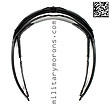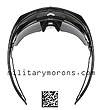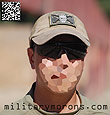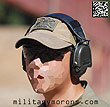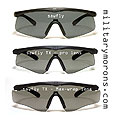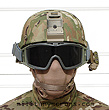Eye Wear
TO VIEW FULL SIZE IMAGES: USERNAME and PASSWORD are both "mm"
4/16/10 - ESS (Eye Safety Systems, Inc) specializes in advanced eye protection for military, LE and public safety professionals. Featured here are two of their eyeshields - the ICE Series and new Crossbow. Also of interest is the Vice Rx insert. ESS is headquartered in Sun Valley, Idaho, and is a leader in eyewear sold to the U.S. military and firefighting markets, and has products sold in over 90 countries. ESS eyewear is manufactured in the USA with strict manufacturing and quality standards, and includes a wide variety of protective eye wear ranging from eyeshields to goggles. I've used ESS goggles in the past, but this is my first experience with their eyeshields. Being very nearsighted, I wear corrective lenses (not contacts), and Rx lenses can get pretty expensive as they're an additional cost on top of a pair of eyeshields or goggles. However, I stopped by the ESS booth at the SHOT show back in January, and was impressed with what I saw, so I decided to give a couple of their products a try. Vice Rx Insert - ESS offers three ICE models of Rx lens inserts; the Vice, and the nylon P-2B and wire-framed Rx Insert. The P-2B is a nylon-framed insert into which the lenses are installed. The Vice Rx insert is a wire-framed insert to which the lenses are held by monofilament, which makes them practically 'frameless' and less noticeable behind the lens of the eyeshield. The Vice can be used with both the ICE eyeshields, the Crossbow eyeshield or the Advancer V-12 goggle. This is the reason I chose the Vice over the P-2B or 2.4 wire frame as I needed to use the insert with the Crossbow as well as the ICE eyeshield. The Vice Rx Insert has a wire bridge that connects the two lenses, and two wires to which the lenses are attached. The lenses are secured to the wire by almost invisible monofilament line. The Vice can be taken to an optometrist or the customer can use ESS's online Rx filling service. The Rx service is not done by ESS in-house, but contracted to an outside source. I decided to use the ESS Rx service. After getting an updated Rx from my optometrist, I used the online Rx form, which was very easy to use. When you use the service, you don't have a choice in lens material. ESS uses shatter-resistant polycarbonate lens material, which maximizes the protection for your eyes. The Vice comes in a semi-hard case with an Rx nosepiece for use with the ICE and Crossbow eyeshields, and a H bracket for use with the Advancer goggle. The Rx nosepiece replaces the standard ICE nosepiece, and is deeper to provide the additional standoff space for the Rx insert behind the main lens. The wire nose bridge of the Vice is snapped into the inner slot of the Rx nosepiece. The Rx nosepiece is then installed onto the main lens the same way the standard nosepiece is.
The ICE (Interchangeable Component Eyeshield) series eyeshields are available in a few different configurations (there are more than what's listed here, but these are the basic ones):
ICE-2X NARO - I have a narrower face, and picked the ICE-2X NARO retail configuration. It was the right choice, as the narrower lenses are perfect on me. Some of the main features of the ICE NARO eyeshields are:
Crossbow - The Crossbow is ESS's newest eyeshield. The Tri-Tech Fit frame is engineered to achieve a universal fit that maximizes comfort without pressure points. It's available in the 2X kit which includes two fully assembled eyeshields, and a 3LS kit with one frame and three lenses. The 2X kit is shown here with two black frame sets with clear and smoke gray lenses, a micro-fiber pouch, zippered hard case and elastic head strap. The hard case will hold only one Crossbow at a time. As with the ICE Naro, the imported case quality leaves a bit to be desired, as the stickers covering the ends of the zippers inside became unstuck. Better adhesive should be used.
Observations/Notes Vice Rx insert - For the Vice Rx Insert, the actual Rx service is performed by Mountain West Optical, and they did a good job on the insert. Prescription seemed correct, and the Vice fit as intended into the ICE NARO and Crossbow eyeshields. When installed into the eyeshields, the Vice requires that the eyeshields sit farther out from your face as they normally would, to accommodate the added thickness of the lens. The Rx nosepiece does that job. One of the issues I've encountered occasionally with inserts is that my eyelashes would sometimes brush against them, as I do not have deep-set eye sockets and my strong prescription results in thicker lenses. This phenomenon is referred to as 'lash bash'. I was happy to discover that it was not an issue with the Vice. The 'frameless' design of the Vice also made them less noticeable in my field of view. One thing common I've noticed when wearing Rx inserts behind a main lens (this is not limited to ESS) is the issue of internal reflections. Depending on where the sun is, the light coming through the main lens hits the front of the Rx insert, and bounces back, sometimes creating some annoying internal reflections. This can be addressed by ordering the Rx insert with an AR (anti-reflective) coating. It was not available as an option on the ESS ordering form, but will be in the near future, I'm told. In any case, you can call Mountain West Optical directly and ask for the AR coating with your order, at an additional charge. It will reduce the amount of internal reflections greatly. Also, because the main lens is further forward because of the insert, more light enters from above, and can add to the reflection by lighting up the Rx frame and lens (so you see the reflection of the Rx insert on the back of the main lens). I found that wearing a cap or hat eliminates much of the internal reflection, and found it essential when using the inserts in bright sunlight. For me, it's a simple solution as my main use for the eyeshields is for shooting, and I wear a cap anyway. ICE NARO - Having a narrow-medium face means that most eyewear can
be a bit wide or loose for me. I wish all eyewear was available in different
widths like the ICE NAROs, as they fit my face perfectly. When frames
are too wide, the temples are squished against the side of my head when
wearing hearing protection. With the NARO, the low profile temples/earpieces
were the most comfortable yet that I've worn under my Sordin headsets,
allowing them to seal up nicely. The pliable and formable ear ends are
a very nice feature to have, as I bent them to fit my ears. Took a little
bit of taking them on and off for adjustment, but once I got them adjusted,
they felt comfortable and secure. Crossbow - At first, I was skeptical of the Crossbow's rigid frame
and 'Tri-Tech Fit'. As mentioned above, the temples/ear pieces are rigid
with a bow shape, rather than straight. They wrap around the head, which
prevents them from slipping off. The main contact points beside the
nosepiece are the ear ends behind the ears. When I first put them on,
I thought 'I can still feel the pressure points'. The ends of the earpieces
'grip' the head behind the ears. I'd consider this a point of pressure,
but after a few minutes of wearing the Crossbows, the I didn't notice
them and the frames were very comfortable.
10/25/10 - The Crossbow Suppressor is a low profile temple version of the ESS Crossbow for use with hearing protection systems. The Crossbow Suppressor has ultra thin temples, which eliminates pressure points without breaking the audible seal of the ear cups. When I wrote about the Crossbow ballistic eyeshield above, I mentioned that the wrap-around temples were comfortable for stand-alone wear, but did not interface well with hearing protection ear cups. Even as I released my writeup, ESS was actually working on a low profile temple version of the Crossbow, and here it is, finally. The Crossbow Suppressor is currently available as part of the Crossbow 2X Suppressor kit shown here, which includes two fully-assembled eyeshields (1 with regular temples, 1 with Suppressor temples), clear and smoke gray lenses, micro-fiber pouch, elastic retention strap and zippered hard case, or by itself as the ONE kit. The hard case will hold both Crossbows in it. The Suppressor utilizes the same lenses as the Crossbow, and shares most of the main features:
Observations/Notes I'm very glad that ESS introduced the Suppressor version of the Crossbow because I really like the lens shape of the Crossbow; I just couldn't use it for shooting with a headset, only ear plugs. The Suppressor temples are surprisingly thin, and are really designed for dedicated wear with headsets. Since they're more flexible, thinner and shorter, they aren't as secure on the head as the wrap-around temples of the regular Crossbow. This is a non-issue, as wearing earphones over them provides the tension needed to retain them. As a prescription eyewear user, with the Vice Rx insert installed in the Crossbow Suppressor, the Rx nosepiece places the whole eyeshield a bit further out from the face than it would normally be without the Rx insert. That, combined with the added weight of the Rx insert, makes using the elastic retention headband a good idea, I found, if you're using the Rx insert. Without the elastic strap, I'd sometimes find the nosepiece slipping on my nose a bit if I got sweaty. The elastic strap completely eliminated that, and kept the Suppressors firmly planted on my head, with and without hearing protectors. When shooting with the Suppressors under my Sordin headset, the ear cups were able to achieve their normal seal and I could not feel any interference whatsoever from the thin Suppressor stems. To date, they're the most comfortable and low profile temples I've used with a headset.
|
Revision Military Sawfly™ Eyewear System (see newer version below)
12/15/05 - The Sawfly Military Eyewear System from Revision Eyewear is designed specifically to meet the demands and features needed for military eye protection. Proper eye protection is an essential part of soldiers' equipment, as they can be exposed to hazards on a daily basis that could result in injury to the eyes and a potential loss of sight. Civvie shooters or law enforcement officers will also benefit from wearing proper eye protection. Revison developed the Sawfly for the Canadian Military, and it's now on the U.S. Army's Authorized eyewear list. Visit Revision's website for more details. The Sawfly System consists of interchangeable protective shields that lock into a slim-line frame with adjustable head strap. It's offered in four different kits:
Shown in this writeup is the Deluxe Kit, which comes with all the trimmings. I'm one of those unfortunate enough to be near-sighted, and resigned to wearing corrective lenses (I dislike contacts and haven't taken the plunge to get laser eye surgery), so I'm restricted to wearing prescription sunglasses. Hence, I also got the prescription lens insert for the Sawfly. On to the main features:
The Sawflys are very comfortable and feel quite secure even when worn without the elastic headband, other than the above mentioned problem I had with slippage when running, caused mostly by the added weight of the prescription inserts. Without the inserts, they're fine and extremely lightweight (1 oz for the system without prescription insert). Wearing a cap to anchor the arms on the ears also worked. I used the Sawflys around town, driving, and also out in the desert while shooting and running around. I wore them with a hat and hearing protection over them, as well as with a helmet, and I pretty much forgot they were on. Definitely more suited to this kind of stuff than the Ray-Bans I usually wear. They also worked well under my full-face motorcycle helmet. The lens shape wraps around the sides and is neither too tall nor narrow (it provides just the right amount of coverage without being obtrusive or getting in the way). Plus, it doesn't hurt that they also look cool. I think the Sawflys are definitely worth taking a look at (and through) if a person's line of work or hobby demands wearing eye protection.
3/1/07 - Update - Shown here is the U.S. Military kit NSN 4240-01-527-4051 with tan frames. The military kit comes with a clear and tinted shield, and a soft case instead of the civilian hard case. The arms have also been updated with the rubber portion extended to the end, which just about reduces the 'slippage' issue I mentioned above. The nose pieces are now molded from a softer compound. I've been using the Sawflys for more than a year now, for all my shooting, hiking and outdoor activities, and they continue to serve my needs very well.
|
Revision Eyewear Sawfly®-TX Tactical Eyewear System (Discontinued)
2/13/09 - The Sawfly-TX Tactical Eyewear System from Revision Eyewear is the next generation ballistic spectacle that is designed to provide superior communications and headset capability with two custom lens shapes for enhanced mission performance. Note that the Sawfly-TX Tactical Eyewear system is currently only available for the international (non-U.S.) market at this time. Like the Sawfly System reviewed above, the Sawfly-TX System consists of interchangeable protective shields that lock into an ultra lightweight slim-line frame with adjustable head strap. Shown in this writeup is the Essential Kit, which comes with the frame with removable retenton strap, clear lens and smoke lens with individual nose pieces, microfiber storage/cleaning pouch and storage case. The prescription (Rx) carrier is optional, and is the same carrier as the Sawfly and Desert Locust Goggle, so I did not need to have a new one made. The Sawfly-Tx shares the main features with the Sawfly, with the difference in the design of those details. Main features:
I've been using the Sawflys for the past 3 years for all sorts of outdoor/shooting activities. The Sawfly-TXs offer a slighly lower profile as the lens is narrower from top to bottom, and are just as comfortable as the Sawflys. For use with headphones/hearing protection, the TX's have the edge over the original Sawflys. While I never had a complaint with the original Sawflys when wearing them with my Sordin headsets, the new TX frames do feel like they allow the ear cups to seal completely, instead of leaving a little gap for the arms. The Max-Wrap lens provides an extra measure of side protection from debris and particles, which is welcome when shooting at steel targets.
|
Revision Military Sawfly™ Eyewear System (New model)
1/18/11 - The Sawfly Military Eyewear System from Revision Eyewear has been redesigned with a new frame, Comms Compatible arms, new Comfort nosepiece, and extended lens and new retention system. The Sawfly was designed specifically to meet the demands and features needed for military eye protection. Civvie shooters or law enforcement officers will also benefit from wearing proper eye protection. The Sawfly is on the U.S. Army's Authorized eyewear list. If you think that the new Sawfly looks a lot like the now-discontinued Sawfly-TX model, you wouldn't be wrong. The Sawfly-TX was only available for the international (non-US market), and it provided the basis for the changes made to the new Sawfly. Like the original Sawfly, the new Sawfly Military Eyewear System provides the same superior ballistics, exceeding ANSI Z87.1-2010 and military ballistic impact requirements MIL-PRF-31013, clause 3.5.1.1 and MIL-DTL-43511D, clause 3.5.10; the same distortion-free vision; and the same rugged durability to protect and perform through all the rigors of combat. Here is a summary of the changes on the new Sawfly:
Not surprisingly, the new Sawfly feels identical to the Sawfly-TX I reviewed previously, so please refer to the above writeup for more comments about how they work. I do notice the difference in rigidity of the temples/arms - the ones on the new Sawfly are less pliable than the TX and 'grip' your head more securely. The thinner temples provide a better seal when using headsets, so shooters will appreciate than. For those who wanted the Sawfly-TX and couldn't get it, the new Sawfly is now available.
|
Revision Military Desert Locust™ Goggle System
5/02/07 - The Desert Locust Goggle System from Revision Eyewear is designed as a single-lens goggle system for extended-use wear that provides ballistic fragment protection. The optically correct, distortion-free lens provides a wide field of view. Foam covered air vents help ventilate the goggle to prevent fogging. The Desert Locust Goggle System consists of interchangeable lenses that lock into a frame that provides a complete facial seal. There are different kits offered:
The Rx carrier is optional and ordered separately from the kits. Shown in this writeup is the Deluxe Kit, with the optional Rx carrier. As mentioned above in the Sawfly review, I need the prescription lens insert to use with the Locust goggles, as they won't fit over normal prescription glasses. The main features are as follows:
I didn't find the frame quite as comfortable as goggles with foam,
but it's a small difference, and a non-issue when worn with a balaclava.
The lack of foam, however, makes the Locust frame easier to wash, and
there's no foam to absorb sweat and oils (and have that nice sweaty
smell). The anti-fogging coating on the lens seemed to work quite well.
When worn with a helmet, air cannot flow through as well because the
top vents are right up against the brim of the helmet. My uncoated prescription
inserts fogged up partially until the temperature stabilized, but the
inside of the main lens never did. That's the problem with wearing prescription
inserts or glasses with goggles - unless they're coated or treated with
anti-fog, they'll have a tendency to fog up as they're closer to the
face, and will be the weak point in the system.
|
Arena Industries Flakjak Goggles
1/22/05 - Shown below is the Flakjak goggle in coyote brown from Arena Industries. Arena Ind. offers two goggles, the Flakjak, and the Mozambik, specifically designed to meet the needs of the U.S. Military and law enforcement. The Flakjak is designed to be worn over a helmet, while the Mozambik is compatible with only certain helmet models and is meant to be worn alone. The Mozambik is designed with maximum peripheral vision and the lens curvature extends back farther than the Flakjak, hence the strap take-off point might be too far back to use with some helmets. Other than that, they both share the same specs. Both are available in black, coyote brown, tan and OD. This is more of a preview, not a full review, as I haven't had a chance to field test the goggles out in the desert under dusty and windy conditions. I figured I'd present the pics and info and update it when I can. Some of the key features of these goggles are:
Overall, these goggles feel pretty solidly built and well designed. To me, the most important feature is the Razorback™ Technology filtration system if it works as advertised. If you can't see what's going on around you, every other feature takes a back seat. |
 Flakjak |
 Showing Razorback vents |
 |
 Tinted lens and high-flow vents |
 SIze comparison |
 Worn over a Canadian helmet |
ATTENTION! PLEASE DO NOT LINK DIRECTLY TO MY IMAGES
-
IT RESULTS IN MY BANDWIDTH ALLOCATIONS BEING EXCEEDED,
AND MY PAGES GO DOWN. THANKS!
/ . PLEASE
OBSERVE AND RESPECT OUR COPYRIGHT! . /
©opyright by MilitaryMorons.com. All Rights Reserved. Reproduction, Duplication,
Distribution Strictly Prohibited.
Unless mentioned otherwise, content and images are the
property of militarymorons.com and are not in the public domain.
They are not to be used without
permission. Please Contact
me for permission to use any images or content herein.



















